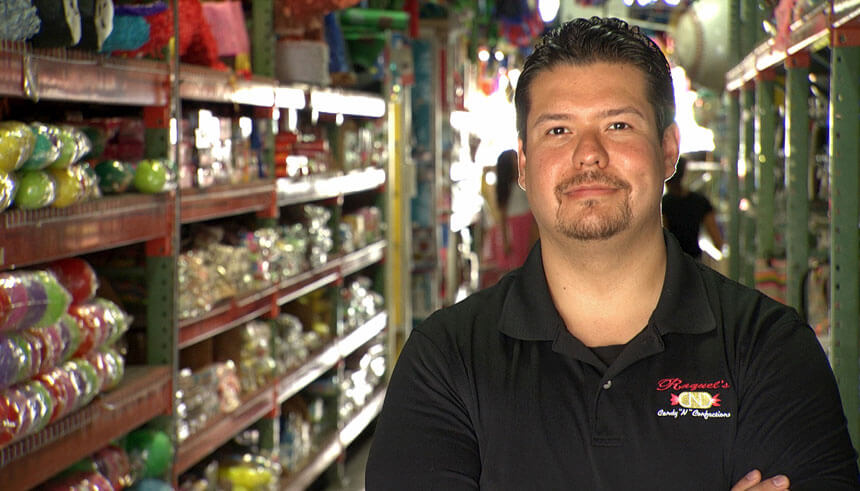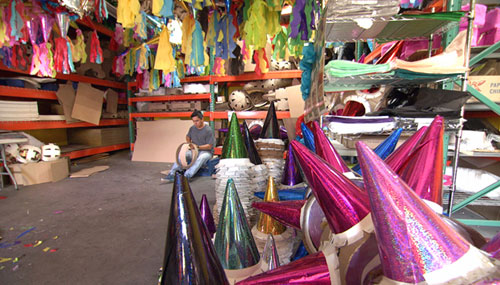Insights
Millennial Entrepreneurs Remake a Piñata Business for a New Generation
By Daisy Lin

Three brothers take over a family business and bring new ideas to a time-honored tradition.
The piñata has gone mainstream. Said by some to have originated in China and brought by Marco Polo back to Italy, the piñata was popularized in Mexico, where it has become synonymous with birthday parties and holidays. These days, the popularity of piñatas is widespread, according to Chris Luna, the chief financial officer of Raquel’s Candy N’ Confections, a large emporium in the so-called Piñata District in downtown LA. He regularly gets requests to make customized piñatas from movie studios, commercial productions, and people of various nationalities for all kinds of special celebrations.
“The piñatas have been trending for the last 6 to 10 years,” Luna says. “Our sales have been increasing year-over-year.”
A few doors away from Raquel’s is the piñata factory where artisans make piñatas by hand, cutting and rolling cardboard into shapes of stars, animals, and human figures, and adorning them with crepe paper in a rainbow of colors. They supply a portion of the 60,000 or so piñatas that Raquel’s Candy N’ Confections sells every year—and they customize, too.
“Anything you can think of, we can make. We have made huge giraffes, huge dinosaurs,” Luna says. “One person even had a piñata-themed wedding.”
Luna and his brothers, who run the business, stand on the shoulders of their parents, who opened up the shop more than three decades ago. But as millennial entrepreneurs, they are putting their own 21st century spin on the family business.
Millennial strategy
Luna’s parents, Roberto and Raquel, launched the business in the 1980s by importing traditional Hispanic products, groceries and candy from Mexico. In the beginning, Roberto Luna would drive a van down to Mexico, fill it up with products, then bring it back to the U.S. and sell from store to store. When the van was empty, he would return to Mexico, refill it and repeat the process. Later, they began getting direct distribution from manufacturers in Mexico and opened up Raquel’s, which became a downtown institution.
After the parents retired, their three sons took over and surveyed the business landscape. They realized it was time to retool, since many Mexican candy manufacturers had since been bought out by big companies in the U.S. and had their own distribution network. That’s when they began to look at piñatas more seriously.
“We’ve found a niche, we saw that piñatas are unique, and not a lot of companies are making them. There are certain trade secrets,” Luna says. “So, we’re just looking at something that not everyone does, and something that not everyone can do.”

Maximizing loans
One of the things that Luna and his brothers decided to do when they took over the business was to streamline operations. After many years in business, the family had purchased multiple properties and held a number of commercial real estate loans (CRE) with various lenders. Some of the smaller loans had higher interest rates, and the cost of refinancing each loan, along with separate appraisals, titles, and environmental reviews for each property, all added up and impacted the bottom line.
After meeting with David W. Lee, vice president and relationship manager at East West Bank, Luna decided to go in a different direction.
“After discussion with Chris, we determined we would consolidate all their loans for different properties under one CRE term loan,” Lee says. “By consolidating all the loans under a single note pledged by subject property, we were able to lower the overall financing cost for their portfolio and request a more competitive pricing.”
The next step for Luna is to look for an equipment financing loan to modernize and improve the piñata production process.
“We’re very technology-driven. We’re trying to see what machines we can use to improve this process,” he says.
Right now, all piñatas are made by hand, which is a slow and laborious process. In the future, they are looking toward automating parts of the process. Some aspects—like the decorating—will always be done by hand, but other parts such as the cardboard cutting can be done by machine, so they can increase speed and volume and take their business to the next level.
Luna says they chose to work with a bank that understands and values small businesses. He talks more about it here:
In the meantime, some things don’t change—such as the fiesta atmosphere at Raquel’s every weekend. The Luna brothers make sure the music is bouncy, the clowns are cheerful, and the candy comes raining down from the piñatas, delighting the children and families.
“When you come to our business, you feel like you’re already at a party,” he says.
Subscribe to the Reach Further Newsletter
Get inspiring stories in your inbox every month.

